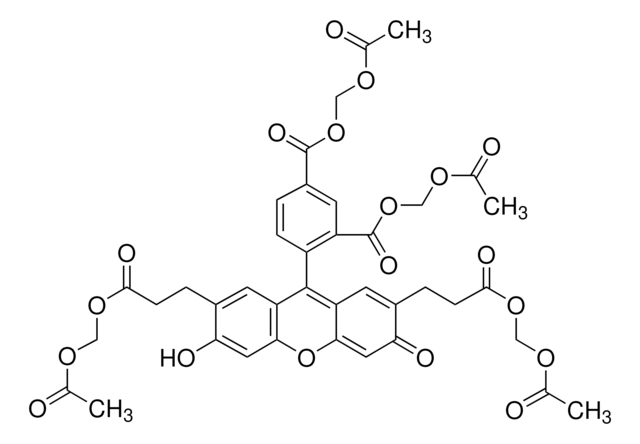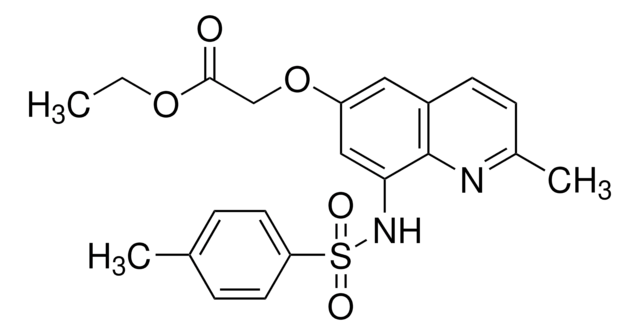Kluczowe dokumenty
46123
1-(Ethoxycarbonylmethyl)-6-methoxyquinolinium bromide
suitable for fluorescence, ≥97.0% (TLC)
Synonim(y):
(6-Methoxyquinolinio)acetic acid ethyl ester bromide, MQAE
About This Item
Polecane produkty
Próba
≥97.0% (TLC)
Formularz
solid
mp
177-179 °C (lit.)
rozpuszczalność
DMSO: soluble
H2O: soluble
methanol: soluble
fluorescencja
λex 350 nm; λem 460 nm in 0.1 M borate pH 8.0 (quenching with Cl-)
przydatność
suitable for fluorescence
temp. przechowywania
2-8°C
ciąg SMILES
[Br-].CCOC(=O)C[n+]1cccc2cc(OC)ccc12
InChI
1S/C14H16NO3.BrH/c1-3-18-14(16)10-15-8-4-5-11-9-12(17-2)6-7-13(11)15;/h4-9H,3,10H2,1-2H3;1H/q+1;/p-1
Klucz InChI
DSLLHVISNOIYHR-UHFFFAOYSA-M
Szukasz podobnych produktów? Odwiedź Przewodnik dotyczący porównywania produktów
Zastosowanie
Inne uwagi
Hasło ostrzegawcze
Warning
Zwroty wskazujące rodzaj zagrożenia
Zwroty wskazujące środki ostrożności
Klasyfikacja zagrożeń
Eye Irrit. 2 - Skin Irrit. 2 - STOT SE 3
Organy docelowe
Respiratory system
Kod klasy składowania
11 - Combustible Solids
Klasa zagrożenia wodnego (WGK)
WGK 3
Temperatura zapłonu (°F)
Not applicable
Temperatura zapłonu (°C)
Not applicable
Środki ochrony indywidualnej
dust mask type N95 (US), Eyeshields, Gloves
Wybierz jedną z najnowszych wersji:
Masz już ten produkt?
Dokumenty związane z niedawno zakupionymi produktami zostały zamieszczone w Bibliotece dokumentów.
Produkty
Nitric oxide (NO) as a signal transporter in neurons, endothelial cells and in the immune system.
Nasz zespół naukowców ma doświadczenie we wszystkich obszarach badań, w tym w naukach przyrodniczych, materiałoznawstwie, syntezie chemicznej, chromatografii, analityce i wielu innych dziedzinach.
Skontaktuj się z zespołem ds. pomocy technicznej







